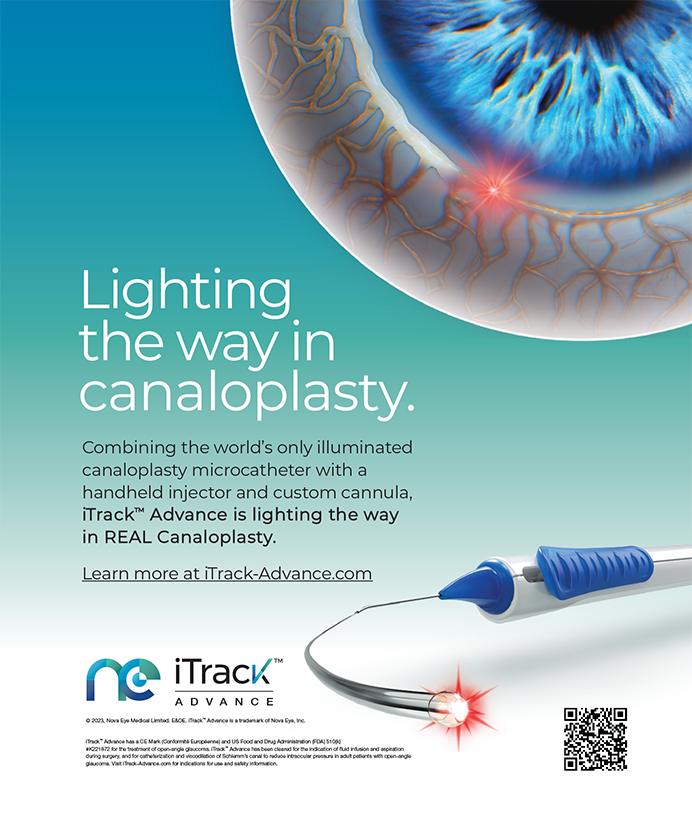
Clinical Outcomes of Femtosecond Laser-Assisted Cataract Surgery Versus Conventional Phacoemulsification Surgery for Hard Nuclear Cataracts
Chen X, Yu Y, Song X, et al1
ABSTRACT SUMMARY
Chen and colleagues compared the clinical outcomes of conventional phacoemulsification and laser cataract surgery in patients with hard cataracts in order to study the effect of each modality on the corneal endothelium and postoperative visual rehabilitation.
This prospective, consecutive, nonrandomized, comparative cohort study included patients with a nucleus grade 4 or 5 according to the Emery-Little classification.2 Patients with Fuchs dystrophy and endothelial cell counts lower than 2,000 cells/mm2 were excluded. There were 48 patients in the conventional group and 47 in the laser group. Preoperatively, there was no significant difference between the two groups in terms of endothelial cell density (ECD), central corneal thickness (CCT), distance UCVA, or corrected distance visual acuity. All surgeries were performed by the same experienced surgeon using the same phaco technique and parameters.
- In a prospective, consecutive, nonrandomized, comparative cohort study, laser cataract surgery was associated with less endothelial damage and a more rapid return to preoperative central corneal thickness than conventional phacoemulsification alone in patients with dense cataracts.
- A prospective randomized trial discovered a way to improve the precision and quality of the laser capsulotomy by increasing the vertical spot spacing, leading to fewer tags with the potential for anterior capsular tears.
For each operation, the investigators recorded the effective phaco time, absolute phaco time, and mean ultrasonic power. Postoperatively, they measured the ECD, CCT, distance UCVA, and corrected distance visual acuity at 1 day, 1 week, and 1 and 3 months.
The investigators found that the absolute phaco time, mean ultrasonic power, and effective phaco time were significantly lower in the laser versus the conventional group. The ECD showed greater endothelial loss in the conventional group compared to the laser group at each postoperative visit.
Although there was a significant increase over preoperative CCT measurements in both groups at 1 day and 1 week, the laser group returned to preoperative levels by the 1-month visit versus the 3-month visit for the conventional group.
The researchers concluded that, compared to conventional phacoemulsification, laser cataract surgery used less phaco power and reduced endothelial loss and corneal edema, thus providing quicker visual rehabilitation in patients with hard nuclear cataracts.
DISCUSSION
This study validates through the scientific method what many practicing laser cataract surgeons anecdotally experience in a clinical setting: clearer corneas and a more rapid visual recovery. By narrowing the scope of the study to dense cataracts, the researchers increased the statistical power of the sample size over what might have been expected with a broader sample of all densities of cataract. In so doing, the investigators demonstrated that using the femtosecond laser lessened the risk of endothelial loss compared to longitudinal phacoemulsification alone in eyes with dense cataracts.
The study warranted a guest editorial by David F. Chang, MD. Although he commended Chen and colleagues on their study design, Dr. Chang justifiably offered a rebuttal in which he pointed to the overall lack of level-one evidence in the literature to support the superiority of laser cataract surgery over conventional phacoemulsification in terms of patients’ outcomes.3
A recently published Canadian meta-analysis of the literature included 2,802 articles comprising 14,567 eyes.4 The researchers concluded that there was no statistical difference in patients’ outcomes between laser cataract surgery and conventional phacoemulsification. The meta-analysis included many of the early reports in the emergence of laser cataract surgery, however, and did not account for the learning curve or surgeons’ experience. There is convincing evidence that a significant learning curve is associated with the laser procedure and that surgeons’ experience decreases complications and improves outcomes.5,6 More recently, Scott and colleagues published a study with 7,155 eyes that showed a significant reduction in the rate of vitreous loss with laser cataract surgery compared to conventional phacoemulsification.7
Much of the debate about laser cataract surgery has centered on the value of this emerging technology. Opponents point to the added time, patients’ cost-sharing expense, and lack of supporting evidence in the literature. Proponents note the precision of the incisions, the nearly perfect capsulotomy, and the safety potential against endothelial damage or vitreous loss. Regardless of one’s perspective on the laser procedure, it is interesting to consider how phaco adoption would have been affected if patients had had to share in the cost or if the foldable IOL had not come along. Perhaps the tipping point for laser cataract surgery lies ahead.
Greater Vertical Spot Spacing to Improve Femtosecond Laser Capsulotomy Quality
Schultz T, Joachim SC, Noristani R, et al8
ABSTRACT SUMMARY
Schultz and colleagues experimented with vertical spot spacing during laser cataract surgery to determine its effect on the quality of the laser cut with respect to the size and number of tags. To date, most default settings for the capsulotomy are based on early experience with the laser technology.
Recent studies have shown that femtosecond laser plasma formation expands vertically more than horizontally.9 Based on these findings, Schultz and colleagues designed a prospective randomized trial comparing standard capsulotomy settings with a vertical spot spacing of 10 µm to an increased vertical spot spacing of 15 µm. The cut depth was held constant at 600 µm.
Patients with grade 2 to 4 nuclear cataract (LOCS III) were included in the study.10 The researchers collected the trypan blue-stained free capsulotomies, which were evaluated by four observers masked to the study versus control group. They graded the capsulotomies for the absence or presence of tags and the size of the tags when present.
The investigators found a significant reduction in the number of tags in the study group with the increased 15-µm vertical spot spacing. Furthermore, with their platform (Catalys Precision Laser System; Johnson & Johnson Vision), the vertical adjustment reduced the capsulotomy time from 1.2 seconds to 1 second.
DISCUSSION
Over the past 4 decades, ophthalmologists’ knowledge and understanding of phacodynamics has expanded, allowing them to modulate power, needle motion, and vacuum to improve surgical outcomes. Ophthalmologists’ knowledge of femtosecond laser dynamics is sure to follow suit, as more surgeons gain experience with the technology.
This study is important because capsular tags increase the risk of anterior capsular tears.5,11 By adjusting the vertical spot spacing, the investigators were able to improve the quality of the capsulotomy and reduce the potential for tags and subsequent complications. Furthermore, the greater vertical spacing increased the speed of the capsulotomy cut time, theoretically reducing the chance of eye movement during the procedure and the risk of a double cut.
The speed of the laser capsulotomy may also have an important role in the intumescent cataract. Conrad-Hengerer et al previously reported on the safety and efficacy of using the laser for intumescent cataracts, and although there were no complications, more than half of the eyes had some form of capsular irregularity, including an incomplete capsulotomy or tags. At 1,000 µm, the researchers’ incisional depth was greater, resulting in a capsulotomy speed of 3 seconds.12 It would certainly be interesting to study the incidence of tags in the intumescent cataract with greater vertical spot spacing and a 600-µm cut depth at a speed of 1 second in hopes of reducing the risk of anterior capsular tears.
1. Chen X, Yu Y, Song X, et al. Clinical outcomes of femtosecond laser-assisted cataract surgery versus conventional phacoemulsification surgery for hard nuclear cataracts. J Cataract Refract Surg. 2017;43(4):486-491.
2. Emery JM, Little JH. Patient selection. In: Emery JM, Little JH, eds. Phacoemulsification and Aspiration of Cataracts; Surgical Techniques, Complications, and Results. St. Louis, MO: CV Mosby; 1979:45-48.
3. Chang DF. Does femtosecond laser-assisted cataract surgery improve corneal endothelial safety? The debate and conundrum. J Cataract Refract Surg. 2017;43(4):440-442.
4. Popovic M, Campos-Möller X, Schlenker MB, Ahmed II. Efficacy and safety of femtosecond laser-assisted cataract surgery compared with manual cataract surgery: a meta-analysis of 14 567 eyes. Ophthalmology. 2016;123(10):2113-2126.
5. Roberts TV, Lawless M, Bali SJ, et al. Surgical outcomes and safety of femtosecond laser cataract surgery: a prospective study of 1500 consecutive cases. Ophthalmology. 2013;120(2):227-233.
6. Bali SJ, Hodge C, Lawless M, et al. Early experience with the femtosecond laser for cataract surgery. Ophthalmology. 2012;119(5):891-899.
7. Scott WJ, Tauber S, Gessler JA, et al. Comparison of vitreous loss rates between manual phacoemulsification and femtosecond laser-assisted cataract surgery. J Cataract Refract Surg. 2016;42(7):1003-1008.
8. Schultz T, Joachim SC, Noristani R, et al. Greater vertical spot spacing to improve femtosecond laser capsulotomy quality. J Cataract Refract Surg. 2017;43(3):353-357.
9. Scott W, Tauber S, Gessler JA, et al. Clinical comparison of effect of sub-one second femtosecond laser capsulotomy on capsulotomy irregularities. Paper presented at: ASCRS Symposium on Cataract, IOL and Refractive Surgery; April 20, 2015; San Diego CA.
10. Chylack LT Jr, Wolfe JK, Singer DM, et al. The lens opacities classification system III. The Longitudinal Study of Cataract Study Group. Arch Ophthalmol. 1993;111(6):831-836.
11. Abell RG, Darian-Smith E, Kan JB, et al. Femtosecond laser-assisted cataract surgery versus standard phacoemulsification cataract surgery: outcomes and safety in more than 4000 cases at a single center. J Cataract Refract Surg. 2015;41(1):47-52.
12. Conrad-Hengerer I, Hengerer FH, Joachim SC, et al. Femtosecond laser-assisted cataract surgery in intumescent white cataracts. J Cataract Refract Surg. 2014;40(1):44-50.




